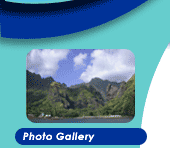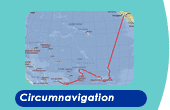March 11, 2003
|
We are finally here in New Zealand after an interesting flight here from Nadi, Fiji. Our Quantas/Air Pacific plane was within ten meters of touching down when it rose, circled awhile, then the pilot came on to explain: “We’re having a bit of weather, and because of the wind crossways to our landing, we think it’s better to go on to Wellington. We’ll sit there awhile until it clears, then take you right back to Auckland.” We had a magnificent view of Wellington, perched on the hillside as the sun set. But that was the end of our luck. Our airplane sat for a few hours on the runway in Wellington. Then all the passengers were unloaded. The airline had decided to have us clear customs in Wellington, since two large planes were scheduled to land in Auckland, which would overload the immigrations system. After clearance, we sat, reading, in a “holding” lounge. We finally arrived at 10:30 PM, rather than 2:30 as scheduled. It was after midnight when we fell asleep. At 0700 there was a knock on our door. “The kids” were here already! Our son, Markus, and daughter-in-law, Sabine, had arrived from Santiago, Chile. They have been backpacking around the world, beginning their adventure in Alaska. They have traveled through all of Central and South America, having reached its southernmost tip before backtracking to take the flight to meet us. Their objective here (other than spending time with us) is to reach the northernmost and southernmost tips of New Zealand. One of my objectives here is to continue my research into the exploration feats of the early Polynesian navigators. Our visit to New Zealand completes the outer triangle that encompasses Polynesia: the lines intersect at Hawaii, Easter Island, and New Zealand. Aotearoa, the Maori name for New Zealand, was the last of the islands to be discovered by these navigators, somewhere between the 10th and 13th centuries. Later this year, when the cyclone season ends and the cruising season begins, we plan to explore and research the inner triangle of Samoa, Tonga, and Fiji. This inner triangle is thought to be the vortex that propelled Polynesian exploration. A Maori historian and anthropologist, Te Rangi Hiroa, also known as Sir Peter Buck, called his ancestors the ‘Vikings of the Sunrise.’ They had begun their explorations in these islands of the Western Pacific, voyaging eastward in their double canoes—predecessors of the modern catamarans—in search of new lands. They left from Samoa, he says, to eventually discover the Marquesas (our first landfall in the South Pacific) and from there they had dispersed through the tropical islands of the Eastern Pacific, even reaching remote Easter Island. Buck describes New Zealand as their last great migration: they had changed course and headed back towards the setting sun.
Imagine the challenge of reaching New Zealand with a sailing vessel from anywhere in Eastern Polynesia! As a modern navigator, I marvel at the audacity of these mariners in undertaking this complex voyage: across the prevailing southeast trade winds, into a southerly belt of unpredictable winds, and then into latitudes of prevailing westerlies. Even today, such a voyage is hazardous, and we know exactly where these islands are. We on Pacific Bliss are wimps. We chose to sail in the tropics and to fly to New Zealand. How did they do it? Most likely, they watched the migrating birds and chose to set off in October or November with following seas and little chance of cyclones. They would have chosen Venus as their reference point, appearing in the southwest for the first three or four hours after sunset. There was no pole star for them at these southern latitudes, but the Southern Cross would have helped to keep them on course and tell them how far south they had sailed. The water temperature, of course, would get colder as they sailed south. These skilled Polynesian voyagers had successfully discovered small islands and atolls in the vast emptiness of the South Pacific. The islands of New Zealand, over 800 miles from north to south, would have been a large target for them. But even so, if they had come from Rarotonga in the Southern Cooks, they would have traveled 2000 miles; if from the Australs, Tahiti or Raiatea, the distance would have been much more. For three or four weeks, the ancient cats had tracked westwards across the ocean. Then the voyagers spotted a long, low-lying cloud on the horizon. As they continued west, legend has it, they spotted the sun setting behind a misty mountainous shape. The closer they came, the larger the cloud grew, until it stretched out in front of them as far as they could see. They had never seen islands as large as these! They had discovered the final uninhabited angle of the vast Polynesian triangle. In fact, they had discovered the last substantial lands to be settled by peoples anywhere in the world. They named these lands Aotearoa, Land of the Long White Cloud. If the Polynesians arrived in New Zealand a little over 1000 years ago, they arrived at an ideal time. A global warming period (déjà vu) had begun about 200 years prior and lasted until the 14th century. It affected global temperatures and changed the course of human history. During the dark ages, wildlife in Europe was endangered due to the severe winters, forcing species farther south. But with the increase of only 1° F, the climate improved and Northern Europe had become almost ‘Mediterranean’. The Norman Conquest brought not only the French to England; it brought their grapevines too, which flourished in the new climate. The Vikings set off across the Atlantic. Eric the Red discovered Greenland, which really was a lush green! It is logical that the migration of the Polynesians also began during the period of global warming. Famines occurred in the Marquesas, forcing them to set out to new lands in further north in Hawaii. Easter Island may have been settled for the same reason. Westward voyaging from the tropics of the Cooks and beyond to the southern latitudes of New Zealand would have been optimum at this time. Skies would have been clearer, storms fewer and less severe, trade winds more predictable. In any event, the New Zealand chapter closes the great age of Polynesian voyaging, about 1000 years ago. First, seafaring people left the security of Southeast Asia to brave the vast Pacific. They adapted to the ocean world as their new home. As they continued to sail eastward, they had to depend on their own resourcefulness as well as the resources of the islands that they discovered and settled. The culture that developed in the Pacific was vibrant, distinctive, and beautiful, reflecting the oceanic world that they had adopted as their new home. After finding such beautiful homes, I am amazed to find that these adaptable people are still migrating to other worlds. This city of Auckland is now the largest Polynesian city in the world. It includes over 60,000 immigrants from other Polynesian islands in addition to its native Maori. More Cook Islanders, for example, live in Auckland than in their largest island, Rarotonga. Hawaii, at the northern apex of the outer triangle, is now the home of over 14,000 Samoans. Over 15,000 Polynesian islanders are now living in the mainland in Los Angeles. Migration and upward mobility seem to be integral parts of the Polynesian spirit. As for Gunter and me, we are pleased with our decision to spend another
year in the South Pacific. The world the Polynesians are leaving behind
we still view as Paradise.
|
|
|
|











